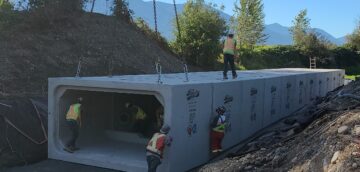A corrugated steel culvert collapsed under the weight of a school bus in Rhome, Texas on Thursday January 26th, leaving the bus stuck with its rear in the air. Only four of the day’s 63 passengers were still on board at the time of the culvert collapse and the driver was able to get those students evacuated with no injuries.
RELATED: Sudbury’s aging bridge and culvert problem
The area had received approximately 150mm of rain in a thirty six hour period preceding the corrugated steel culvert collapse and it is speculated that this rainfall washed away much of the pipe’s soil support. The bus driver stopped the bus short of the culvert and then stopped again after her front wheels rolled over the culvert and immediately started to sink.
The culvert collapse was one of two crossings on Heritage Creek Road built originally as low-water crossings in the mid nineteen eighties. Their maintenance has been the responsibility of Wise County road crews most of the time since.
Wise County Commissioner Danny White said his road crews inspected the other low-water crossing on Heritage Creek Road several times before and after Thursday’s incident. “We inspected that bridge – that crossing; I’m not going to call those things bridges – Thursday afternoon before we left,” White said. “I was back Friday morning before 8 o’clock and the water level was still high. I was down there Saturday and Sunday.
“The main thing is no one was hurt,” White said. “Everything else can be put back as good as it was or better than it was.” The commissioner said the narrow, one-lane crossing will be replaced by a 24- foot, two-lane bridge 53 feet in length.

A near catastrophe like this in the United States should encourage us to take a close look at our buried infrastructure across Ontario. In 2009 the Executive Director of the Sudbury Student Services Consortium (SSSC) wrote to her local MPP after a television report of deteriorating and severely corroded culverts under a section of the Trans-Canada Highway west of the City of Greater Sudbury.
In that letter she offered the following statistics:

These statistics from just one area of Ontario are certainly thought provoking. It prompts one to consider the entire Province of Ontario and all the culverts and bridges that we travel over every day without ever considering the state of our provincial infrastructure.
The Ontario Structure Inspection Manual (OSIM) includes the following definition for a bridge: A structure which provides a roadway or walkway for the passage of vehicles, pedestrians or cyclists across an obstruction, gap or facility and is greater than or equal to 3m in span.
There are an estimated 2,800 bridges on the Ministry of Transportation of Ontario network and 12,800 bridges that are maintained by municipalities. Ontario is the only province in Canada to legislate a requirement that provincial bridge inspections occur every two years and are conducted by or under the supervision of a professional engineer. A bridge inspector must be a professional engineer or a technician with bridge inspection experience. Additionally, Ontario’s bridge inspectors must complete the Ministry of Transportation bridge inspection course. During this course, inspectors are updated on what bridge components to inspect, how to inspect each component, how to identify a defect, how to record information from the inspection and how to make recommendations for bridge repairs. To ensure that inspectors are up-to-date on the latest in bridge safety, they are expected to attend this course every two years.
A culvert means a drainage structure designed to allow the passage of surface water, livestock or pedestrians under a roadway, railway or roadside entrance. There are an estimated 60,000 culverts under the Ministry of Transportation of Ontario’s (MTO) highways and probably over 200,000 culverts under municipal roads and streets. Nobody knows the exact numbers at this stage and that is part of a bigger problem. Culvert inspections are not legislated in Ontario. MTO is attempting to have condition assessments of all centreline culverts conducted every five years. Culverts that have previous condition ratings of Fair, Poor or below Minimum Tolerable are inspected every year. Culvert inspections in municipalities vary.
I have reviewed hundreds of culvert inspections reports of culverts currently in service under Ontario’s highways. Many of these culverts should have been replaced years ago. The reality is that there are not enough funds to replace or rehabilitate all the culverts in question. The image of a school bus stuck in a crater caused by a collapsed corrugated steel pipe is very disturbing. This could easily happen in Ontario. Hopefully if it does we will be as lucky as the children in Texas.

In 2020, the District of Kent in Agassiz, B.C. engaged Urban Systems to design the ...

Precast concrete box culverts and other drainage structures are being supplied to the City of ...

System evaluationA buried pipeline is a system that integrates the properties of the soil surrounding ...
